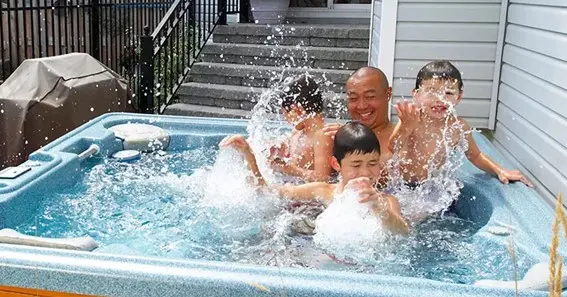A few chemicals are essential to maintaining clear and clean water in your hot tub. Additionally, some aren’t truly required.
The order in which you add every substance to the hot tub is also important. Ineffective chemicals can be produced, and hazy water can be caused by adding the incorrect compounds in the wrong order.
This is a comprehensive guide that will show you which chemicals are essential for your hot tub, which ones you may omit, and what sequence to add them in.
For a Hot Tub, What Chemicals Are Necessary?
You must have the following hot tub additives on hand in order to maintain the water’s balance and prevent serious issues including the growth of bacteria, algae, and biofilm:
- Hot tub disinfectant, such as bromine or chlorine
- Sauna shock
- An alkalinity enhancer
- pH booster
- pH reducer
- Increaser of calcium hardness
- A cleaner for lines
- Optional: metal sequestrant, filter cleaner, and water clarifier
You must test your hot tub’s water before adding any more components. A sufficient quantity of test strips is necessary. You may also use a fluid test kit to get findings that are more accurate.
Also Read N: Is Atlas Earth Legit? Can You Really Earn Money With It?
If you would like to test the source of your water for aluminum or other minerals, you can also bring a sample of the water to your neighborhood pool and spa store. You can begin adding your chemicals after having determined your baseline values. The proper hot tub chemicals composition are as follows:
Hot Tub Cleaner
Also Read P: Enhance Your Chill: The Benefits of Delta 8 THC Gummies
The first step is to choose the type of disinfectant you wish to use, most often bromine or chlorine. Each has advantages and disadvantages.
Chlorine: To sanitize their water, many owners of outdoor hot tubs use chlorine. It kills germs and algae aggressively and is inexpensive, simple to add, and monitor. The drawbacks? The fragrance of chlorine.
By oxidation, chlorine destroys pollutants. However, waste chemicals known as chloramines are released during this chemical reaction, which is what gives out the scent. It’s likely that your water’s chlorine supply has run out and you need to add extra if you can smell chlorine.
Recall that a sauna’s optimal chlorine level is between 1 and 3 parts per million.
Two pounds of SpaGuard Hot Spa Granular Chlorine
This stabilized chlorine comes in granular form and dissolves quickly. It may be added straight to the water in your sauna. This product works well in outdoor saunas exposed to UV light since it contains CYA (stabilizer).
Bromine: Your sauna won’t smell like chlorine when bromine is used. It is also less acidic than chlorine and lasts longer, which makes maintaining the pH balance of the water a little bit simpler.
Additionally, because it is kinder to the skin, a lot of sauna owners choose to use it. However, it costs more and tends to operate more slowly. It’s unstable as well. It will thus burn up very fast in an unprotected outdoor sauna when exposed to the sun.
Bromome: For saunas that aren’t exposed to direct sunlight, such as indoor models, bromine works well. 3–5 ppm is the ideal bromine level.
Granular Bromine for SpaGuard Hot Tub – 2 lbs
You may add these bromine granules straight to your water and they will dissolve rapidly. This powdered bromine is an excellent choice for sanitizing your spa whether you have an interior sauna, an enclosed sauna, or you just want to stay away from that “chlorine smell”. Or you may get a sauna system that uses salt water.
Hot Tub Shock
A sauna shock is an essential tool for routine hot tub maintenance and an excellent issue solution. It helps replenish the sanitizer in your current container so that it continues to prevent the growth of bacteria, algae, and contaminants.
Additionally, a chlorine shock might assist in clearing up pollutant buildup if you observe hazy sauna water or algae beginning to form. Here’s when and when each kind of sauna shock should be used:
Use either non-chlorine or chlorine shock for your sauna (chlorine or bromine). Regular maintenance is greatly enhanced by non-chlorine shock, which allows you to use your sauna immediately after shocking.
These chlorine shocks help address algae issues in your sauna and lessen the spread of germs. It works well in spas with salt or chlorine water. To maintain low amounts of chlorine in your mineral hot tub, use non-chlorine shock. However, apply chlorine shock if you have algae problems or murky water.
Use chlorine shock in your saltwater hot tub. For those who are concerned about very high chlorine levels, using a non-chlorine shock is acceptable.
Cleaner for Hot Tub Pipe Flush
Your hot tub’s plumbing may start to gather filth, debris, and mineral deposits over time. The only method to remove that accumulation is to empty your hot tub and use the drain flush cleaning.






